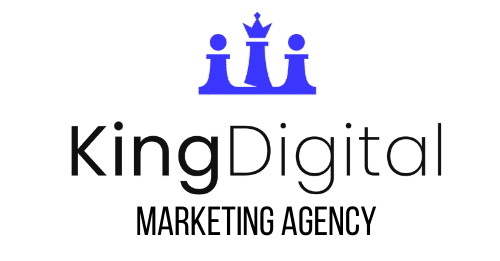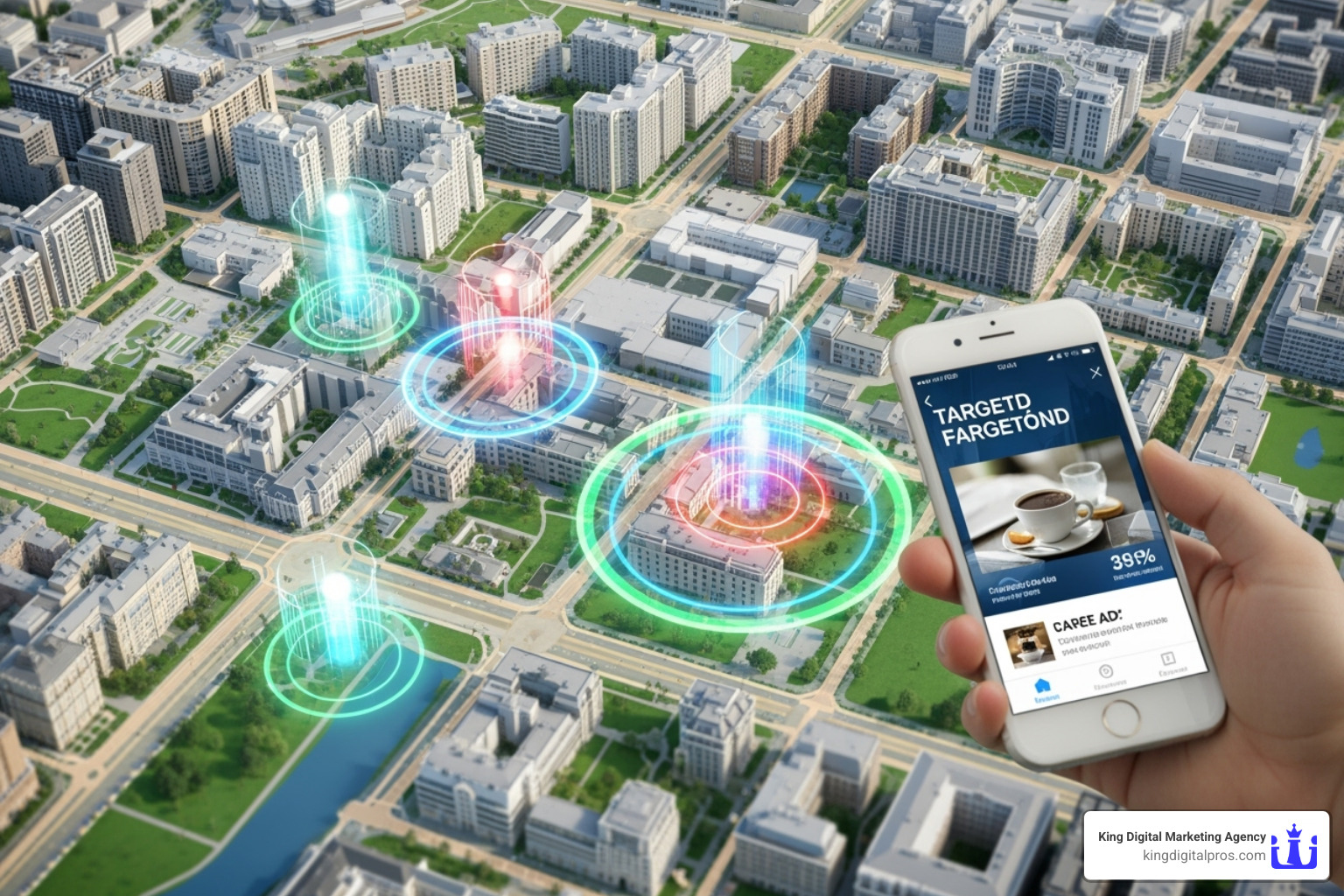Why Geofencing Marketing is Changing Local Business
Geofencing Marketing is a location-based strategy that uses virtual boundaries to deliver targeted ads to mobile devices when users enter or exit specific geographic zones.
Key Elements of Geofencing Marketing:
- Virtual Boundaries: Digital fences around locations using GPS, Wi-Fi, or cellular data.
- Real-Time Targeting: Instant ad delivery when a customer enters your defined area.
- Mobile-First Approach: Reaches customers on smartphones and tablets.
- Proximity-Based: Triggers messages based on physical location.
- Actionable Results: Drives immediate store visits, calls, or purchases.
The global geofencing market is forecasted to grow from $2.65 billion in 2024 to $12.23 billion by 2032. This growth is fueled by results: 53% of shoppers visit a retailer after receiving a location-based message, and over 70% of consumers prefer personalized ads.
Imagine walking past a coffee shop and receiving a notification: “20% off your next latte – valid for the next hour!” This is geofencing in action, connecting with customers when they are most likely to buy.
I’m Bernadette King, founder of King Digital Marketing Agency. I’ve helped many local businesses use Geofencing Marketing to increase foot traffic and sales through strategic, location-based campaigns.
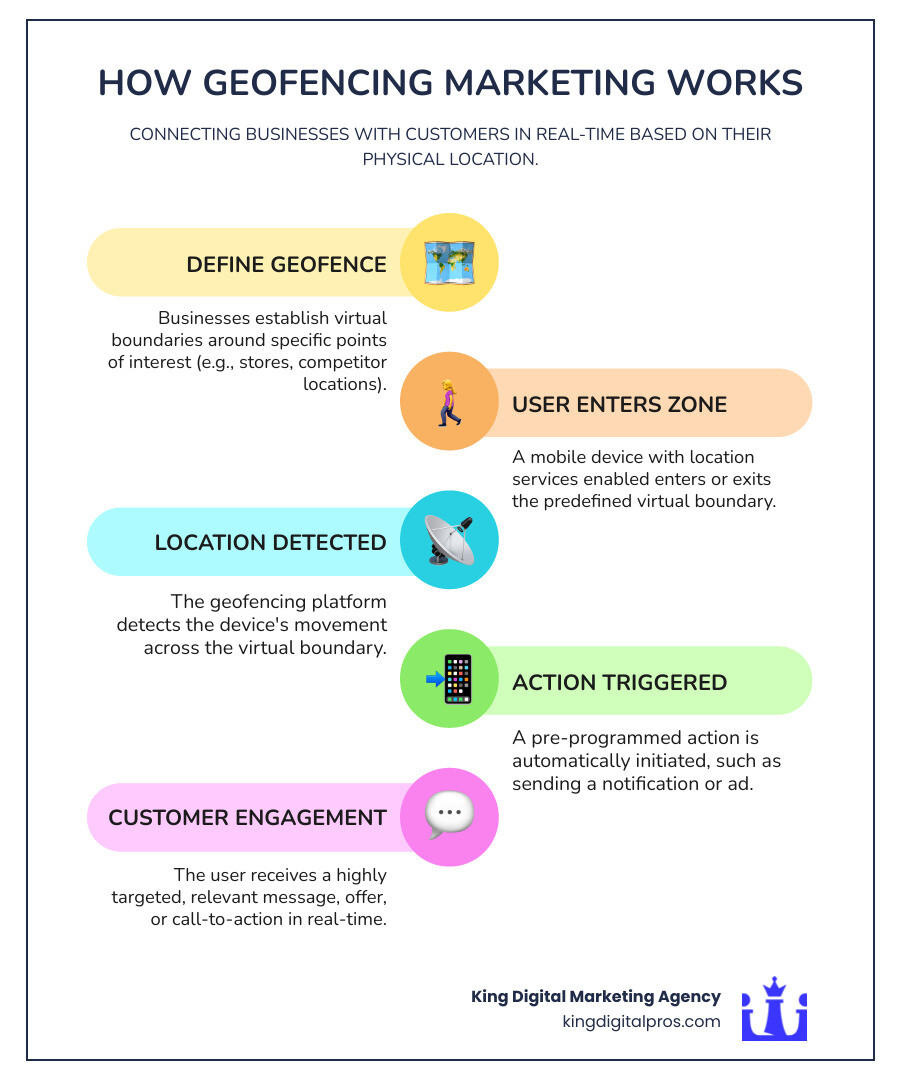
Understanding the Power of Geofencing Marketing
Think of geofencing marketing as a digital doorbell for your business. It creates invisible boundaries around locations that matter to you, like your store or a competitor’s. When a potential customer with a smartphone crosses one of these lines, your marketing message appears on their device instantly.
Instead of advertising to an entire city, you’re engaging with people who are already in your neighborhood. This precision makes your marketing dollars work harder and helps you connect with customers who are most likely to visit. This is why the geofencing market is projected to see massive growth, reaching $12.23 billion by 2032. Geofencing Marketing delivers the personalized experience modern consumers want, making your ads helpful rather than intrusive.
How Geofencing Technology Works
Your phone’s location awareness is powered by a combination of technologies.
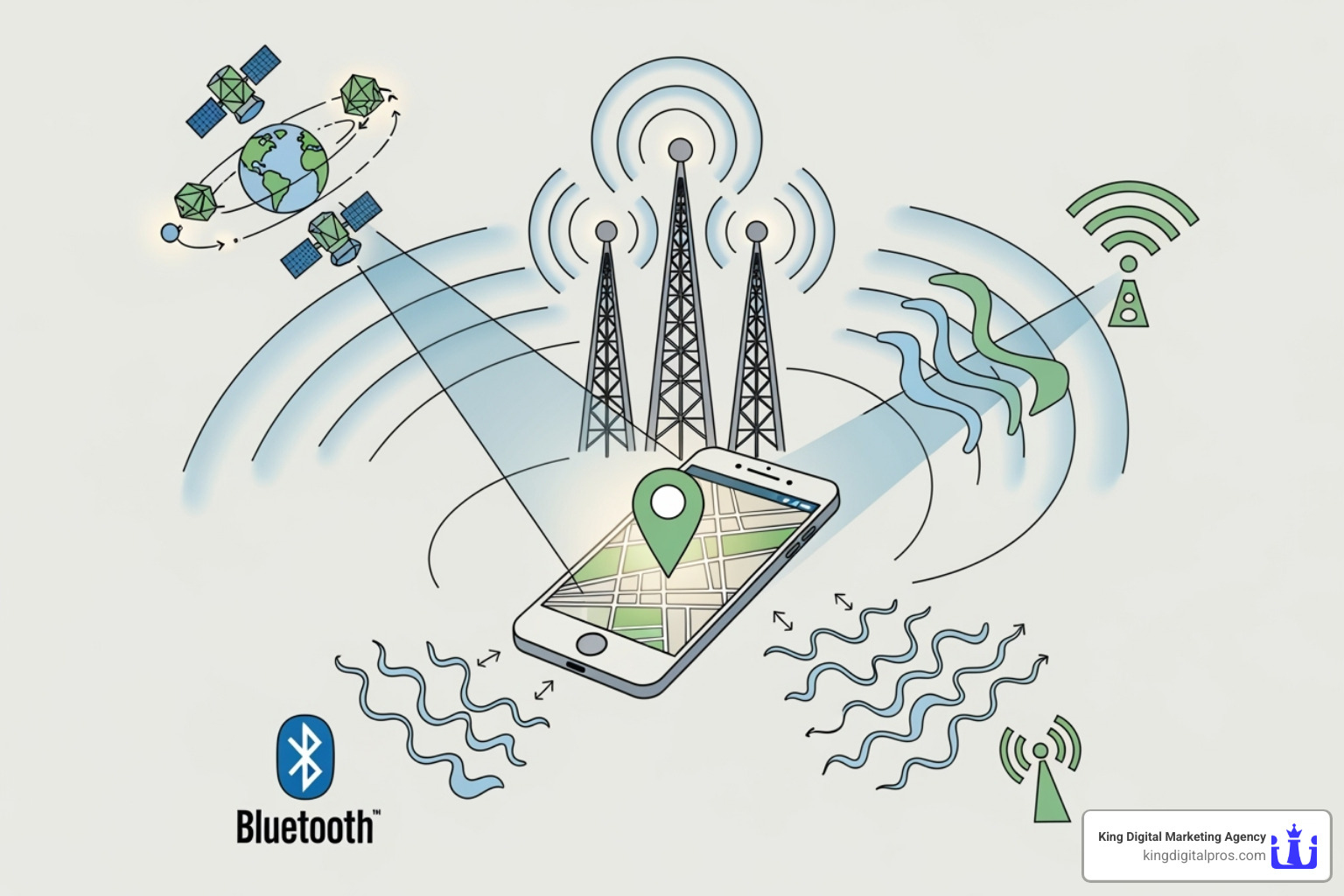
- GPS: Uses satellites to pinpoint a device’s location outdoors with high accuracy (5-20 meters), perfect for targeting customers near your storefront (see GPS.gov on accuracy).
- Wi-Fi: Scans for nearby networks to determine location in dense urban areas or inside malls where GPS is less reliable.
- Cellular Data: Triangulates position using cell towers as a backup when GPS and Wi-Fi are unavailable.
- Bluetooth guides: Small transmitters that offer pinpoint accuracy indoors, allowing you to target customers in specific aisles or near checkout counters (see Bluetooth Low Energy guides).
The process begins when you draw a virtual fence on a map using geofencing software. User consent is crucial; users must opt-in to location services and notifications (see Apple’s guidance on Core Location authorization). Once they grant permission and enter your geofence, your message is delivered instantly.
Geofencing vs. Geotargeting: What’s the Difference?
While often confused, these two strategies serve different purposes. Geofencing is like a motion sensor, triggering ads in real-time based on proximity. Geotargeting is like sending mailers to a zip code, targeting users based on broader location data.
| Feature | Geofencing | Geotargeting |
|---|---|---|
| Trigger | Real-time entry/exit from a virtual boundary | User’s general location (e.g., city, zip code) |
| Precision | Hyper-local, small radius | Broader areas (e.g., cities, neighborhoods) |
| Timing | Immediate, action-triggered | Not necessarily real-time |
| Interaction | Proximity-based, near a physical location | Audience-based, within a geographical segment |
| Goal | Drive immediate action and foot traffic | Build brand awareness, reach a general audience |
| Analogy | A “sniper rifle” – highly precise | A “shotgun” – broader reach |
Geofencing targets who’s here right now, making it ideal for time-sensitive offers. Geotargeting focuses on who lives or works in this area, which is better for building general brand awareness. Use geofencing for immediate action and geotargeting for long-term community engagement.
Key Benefits and Advantages for Businesses
Unlike traditional advertising that often feels like a shot in the dark, geofencing marketing offers precision. It allows you to reach people at the exact moment they are most likely to buy, leading to a significantly improved return on investment (ROI). By focusing your budget on customers who are physically near your business, you eliminate wasted ad spend.
This strategy also provides a powerful competitive edge by allowing you to target customers near a competitor’s location with a better offer. The improved customer data you collect-such as peak visit times and effective messages-helps you understand your audience on a deeper level and make smarter business decisions.
The Top Benefits of Geofencing Marketing
- Hyper-Personalization: Geofencing delivers the targeted experiences that modern consumers expect. In fact, more than 70% of consumers favor personalized ads. A personalized welcome message or offer can build loyalty and drive repeat business.
- Cost-Effectiveness: By focusing your budget only on potential customers in the right place at the right time, geofencing ensures your marketing spend is highly efficient.
- Data-Driven Insights: Track which locations drive the most foot traffic, what offers perform best, and how your campaigns directly translate into store visits. This data is invaluable for optimizing all your marketing efforts.
- Increased Local Sales: Geofencing drives immediate action. Research shows that 53% of shoppers visit a retailer after receiving a location-based message, a conversion rate most channels can’t match.
Geofencing works best when integrated with other local strategies. We combine it with optimized Google Business Profiles to create a complete system for attracting customers via Google Maps.
Top Industries Benefiting from Geofencing
While versatile, geofencing is especially effective for:
- Retail: Announce flash sales or notify customers about in-store pickup.
- Restaurants and Cafes: Promote lunch specials or happy hour deals to nearby office workers.
- Automotive: Target competitor locations with service specials or send maintenance reminders.
- Healthcare: Send appointment reminders or promote seasonal health screenings.
- Real Estate: Market open houses to people in the neighborhood.
- Events and Tourism: Engage event attendees or target tourists with local deals.
Crafting and Launching Your Geofencing Campaign
A successful Geofencing Marketing campaign requires strategic planning, smart execution, and compelling content. Success depends on careful setup, continuous performance tracking, and data-driven optimization. This is the core of our approach to help businesses Grow Local Business.
Step-by-Step Guide to Setting Up a Campaign
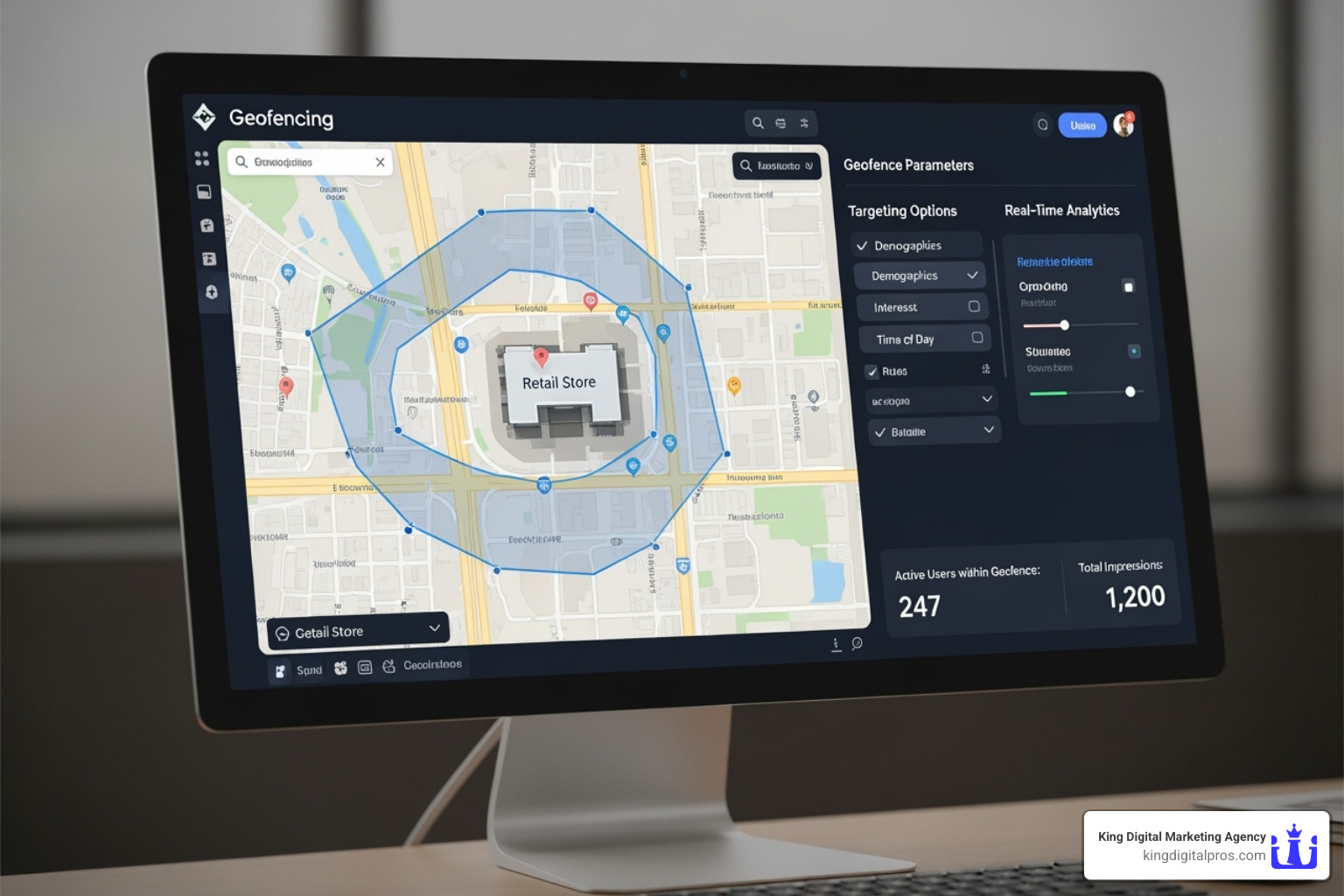
- Define Clear Objectives: What do you want to achieve? Increase foot traffic during slow hours? Attract customers from a competitor? Your goals will guide every decision.
- Identify Your Target Audience: Understand your ideal customer’s demographics, interests, and habits to create messages that resonate.
- Choose Strategic Locations: Geofence your own business, competitor locations, complementary businesses (e.g., a coffee shop fencing a nearby bookstore), or community hotspots like event venues and shopping districts.
- Create Compelling Offers: Your message must offer genuine, time-sensitive value. “Flash Sale: 20% off today only!” is more effective than a generic ad.
- Set a Clear Call-to-Action (CTA): Tell users exactly what to do next, such as “Get Directions,” “Call Now,” or “Shop Online.”
- Launch and Monitor: The real work begins after launch. Continuously track performance and make adjustments based on data to improve results.
Essential Tools for Geofencing Marketing
The right tools are critical for success. Our Geofencing Marketing Software Ultimate Guide offers detailed comparisons, but here are the basics:
- Geofencing Platforms: Software to draw virtual fences, manage campaigns, and track results.
- Mobile Apps: While not required, your ads can appear in thousands of popular apps your customers already use.
- Analytics Dashboards: Tools to turn raw data on views, clicks, and store visits into actionable insights.
- Location Data Providers: For advanced campaigns, these services offer deeper audience insights and wider reach.
Measuring Campaign Success and ROI
Track these key performance indicators (KPIs) to measure what’s driving revenue:
- Foot Traffic Analysis: The number of store visits generated by your ad. This is a primary metric for brick-and-mortar businesses.
- Click-Through Rate (CTR): The percentage of people who click on your ad, indicating message relevance.
- Conversion Rate: The percentage of users who complete a desired action (e.g., make a purchase, redeem a coupon).
- Cost Per Acquisition (CPA): How much you spend to acquire each new customer.
- Dwell Time: How long customers stay in your store, which can correlate with satisfaction.
- Return on Ad Spend (ROAS): The total revenue generated for every dollar spent on advertising. For example, one business used geofencing to generate $172,000 in revenue in just 60 days.
Best Practices, Challenges, and Privacy
Success with geofencing marketing requires a focus on user experience, optimization, and ethics. The best campaigns balance precise targeting with respect for customer privacy, an approach that aligns with building online trust, similar to our Services: SEO Services. Think of it as a friendly invitation, not a constant interruption.
Best Practices for a Successful Campaign
- Set a Relevant Fence Radius: A coffee shop might use a two-block radius, while a furniture store may need a wider one. The fence should match how far customers will travel for your product.
- Deliver Value-Driven Offers: Give users a compelling reason to visit, like a time-sensitive discount or a free item with purchase.
- A/B Test Your Creatives: Regularly test different headlines, offers, and images to see what resonates with your local audience.
- Ensure Message Timeliness: Match your offers to the right time of day. Don’t send breakfast specials in the afternoon.
- Limit Notification Frequency: Avoid ad fatigue by sending no more than one message per user per day. Quality is more important than quantity.
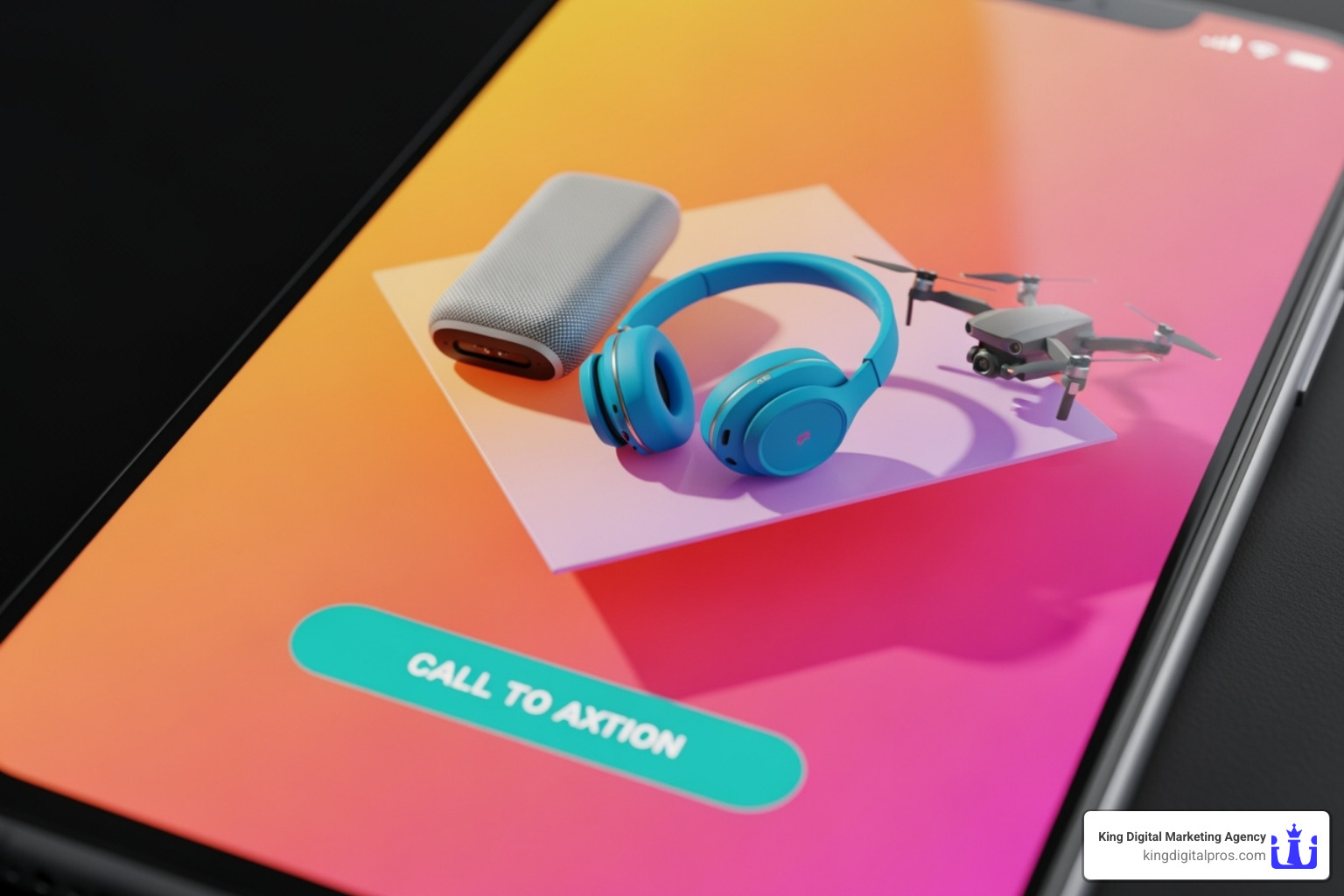
Potential Challenges and Disadvantages
Be aware of these common obstacles:
- Inaccurate Location Data: GPS can be less reliable indoors or in dense urban areas, potentially causing delayed messages.
- Battery Drain Concerns: Constant GPS use can drain a phone’s battery, leading some users to disable location services.
- Ad Fatigue and Opt-Outs: Too many or irrelevant messages will cause users to ignore your ads or opt out entirely.
- Implementation Complexity: Effective geofencing is not “set it and forget it”; it requires ongoing management and optimization.
Navigating Privacy Regulations and User Consent
Privacy is non-negotiable. Regulations like GDPR and CCPA govern location-based marketing, and non-compliance can lead to heavy fines. The Federal Trade Commission also emphasizes transparency in data collection.
- Transparency: Clearly explain in your privacy policy why you collect location data and how it’s used.
- Explicit Consent: Users must actively and knowingly agree to share their location and receive messages.
- Clear Opt-Out Options: Provide an easy way for users to stop receiving your communications at any time.
- Data Security: Protect user location data with robust security measures to maintain trust and legal compliance.
Respecting these principles builds long-term customer relationships and ensures your campaigns are both effective and compliant.
Frequently Asked Questions about Geofencing Marketing
Here are answers to some of the most common questions about geofencing marketing.
Can you use geofencing without a dedicated business app?
Yes. This is a common misconception. You don’t need your own app. Geofencing works through a network of thousands of popular mobile apps that users already have on their phones. When a user with location services enabled enters your geofence, your ad can appear in the apps they are using, such as social media, news, or weather apps.
How accurate is geofencing?
Accuracy depends on the technology. GPS is highly accurate outdoors (5-20 meters), making it ideal for fencing storefronts or event venues (see GPS.gov on accuracy). For indoor or dense urban areas, Wi-Fi and Bluetooth guides offer greater precision, sometimes down to a few meters, allowing for hyper-targeted offers within a store (see Bluetooth Low Energy guides).
What are the typical costs of a geofencing campaign?
Costs vary based on the size of your geofenced area, audience size, and campaign duration. Most platforms use a Cost Per Mille (CPM) model, where you pay per thousand ad impressions. This makes geofencing a scalable and cost-effective solution, as you only pay to reach people in a position to visit your business. It’s an efficient strategy, which is why our Digital Marketing Agency for Small Businesses often recommends it.
What are the different types of geofencing marketing strategies?
- Competitor Conquesting: Target areas around your competitors to lure their customers away with better offers.
- Event Targeting: Reach potential customers at conferences, festivals, and local events.
- Loyalty Programs: Reward existing customers with special offers when they visit your location.
- Location-Based Offers: Deliver timely discounts to nearby consumers to drive immediate foot traffic.
- Behavioral Retargeting: Re-engage users who have previously entered your geofenced areas.
How can geofencing be integrated with other marketing channels for a comprehensive strategy?
Geofencing is most powerful when integrated into a broader strategy.
- Social Media: Promote your geofenced offers on social platforms to expand reach.
- Email and SMS Marketing: Follow up with users who interact with your ads to nurture leads.
- Pay-Per-Click (PPC): Combine geofencing with PPC to ensure your ads are only shown to users in specific geographic zones.
- CRM Integration: Merge geofencing data with your customer relationship management system for a complete view of customer behavior.
Conclusion
Geofencing marketing is a transformative strategy for local businesses, bridging the digital and physical worlds by delivering targeted messages at the perfect time and place.
This guide has shown how geofencing uses location data to deliver hyper-personalized offers. The results are clear: with 53% of shoppers visiting a retailer after receiving a location-based message, the technology drives real foot traffic and measurable ROI. The market’s projected growth to $12.23 billion by 2032 underscores its value across all industries.
While challenges like privacy regulations and ad fatigue exist, they can be managed with best practices. By delivering value, respecting user consent, and optimizing campaigns, geofencing becomes a tool that customers appreciate. As technology evolves, mastering geofencing marketing will provide a significant competitive advantage.
At King Digital Marketing Agency, we specialize in using this technology to boost visibility and engagement. We know that successful geofencing is about creating meaningful connections that bring customers to your door.
Ready to transform how you reach local customers? Learn more about our Geofencing Marketing services and find how we can build a custom strategy to connect you with your ideal customers when they’re ready to buy.
